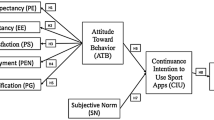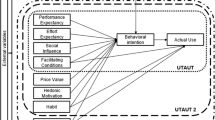Abstract
Physical activity is one of the ways that can reduce the risk to get obesity and chronic disease. The smartphone sport tracker application is one of innovative device that people can use to motivate them involve in physical activity. In this study researcher investigate satisfaction and motivation level of people who involved in physical activity with using smartphone sport tracker application. The intervention cross-sectional research design was used in this study. The Post-Study System Usability Questionnaire (PSSUQ) and Motivational for Physical Activity and Exercise/Working Questionnaire are used as instruments in this study. Research participants were 50 peoples who involved in physical activity at Taman Bandar Kuantan recreational park. Result shows intrinsic motivation slightly higher than extrinsic motivation in performing physical activity. This study found that the smartphone sport tracker application alone can’t lead people to motivate them in performing physical activity.
Access this chapter
Tax calculation will be finalised at checkout
Purchases are for personal use only
Similar content being viewed by others
References
Abidin, N.Z., Zaibidi, N.Z., Zulkepli, J.H.: The role of physical activity to control obesity problem in Malaysia. In: AIP Conference Proceedings (2014). https://doi.org/10.1063/1.4887751
Andone, I., Błaszkiewicz, K., Eibes, M., Trendafilov, B., Montag, C., Markowetz, A.: How age and gender affect smartphone usage. In: Proceedings of the 2016 ACM International Joint Conference on Pervasive and Ubiquitous Computing Adjunct (UbiComp 2016) (2016). https://doi.org/10.1145/2968219.2971451
Asimakopoulos, S., Asimakopoulos, G., Spillers, F.: Motivation and user engagement in fitness tracking: heuristics for mobile healthcare wearables. Informatics (2017). https://doi.org/10.3390/informatics4010005
Cheong, S.M., Kandiah, M., Chinna, K., Chan, Y.M., Saad, H.A.: Prevalence of obesity and factors associated with it in a worksite setting in Malaysia. J. Community Health (2010). https://doi.org/10.1007/s10900-010-9274-1
Chuan, C.C., Yusof, A., Soon, C.C., Abdullah, M.C.: Application of theory of planned behavior to predict recreational sports activities participation of students in Malaysia. J. Phys. Educ. Sport (2014). https://doi.org/10.7752/jpes.2014.02027
Glick, G., Druss, B., Pina, J., Lally, C., Conde, M.: Use of mobile technology in a community mental health setting. J. Telemed. Telecare (2016). https://doi.org/10.1177/1357633X15613236
Hoare, E., Stavreski, B., Jennings, G., Kingwell, B.: Exploring motivation and barriers to physical activity among active and inactive australian adults. Sports (2017). https://doi.org/10.1021/jacs.8b06460
Hoy, M.B.: Personal activity trackers and the quantified self. Med. Ref. Serv. Q. (2016). https://doi.org/10.1080/02763869.2016.1117300
Jarrahi, M.H., Gafinowitz, N., Shin, G.: Activity trackers, prior motivation, and perceived informational and motivational affordances. Pers. Ubiquit. Comput. (2018). https://doi.org/10.1007/s00779-017-1099-9
Justine, M., Azizan, A., Hassan, V., Salleh, Z., Manaf, H.: Barriers to participation in physical activity and exercise among middle-aged and elderly individuals. Singap. Med. J. (2013). https://doi.org/10.11622/smedj.2013203
Kettunen, E.: Activity trackers and fitness centre members – motivation and awareness. In: 30th Bled eConference: Digital Transformation – from Connecting Things to Transforming Our Lives (2017). https://doi.org/10.18690/978-961-286-043-1.21
Lee, H.E., Cho, J.: What motivates users to continue using diet and fitness apps? Application of the uses and gratifications approach. Health Commun. (2017). https://doi.org/10.1080/10410236.2016.1167998
Lee, I.M., Shiroma, E.J.: Using accelerometers to measure physical activity in large-scale epidemiological studies: issues and challenges. Br. J. Sports Med. (2014). https://doi.org/10.1136/bjsports-2013-093154
Lewis, J.R.: IBM computer usability satisfaction questionnaires: psychometric evaluation and instructions for use. Int. J. Hum.-Comput. Interact. (1995). https://doi.org/10.1080/10447319509526110
Lewis, J.R.: Psychometric evaluation of the PSSUQ using data from five years of usability studies. Int. J. Hum.-Comput. Interact. (2002). https://doi.org/10.1080/10447318.2002.9669130
Lu, F., Lemonde, M.: Reducing adolescent obesity with a social networking mobile fitness application. In: 2014 IEEE 16th International Conference on e-Health Networking, Applications and Services (HealthCom 2014) (2015). https://doi.org/10.1109/HealthCom.2014.7001881
Martin, M.R., Melnyk, J., Zimmerman, R.: Fitness apps: motivating students to move. J. Phys. Educ. Recreat. Dance (2015). https://doi.org/10.1080/07303084.2015.1054214
Mekky, H., Hao, F., Mukherjee, S., Zhang, Z.-L., Lakshman, T.V.: Application-aware data plane processing in SDN. In: Proceedings of the Third Workshop on Hot Topics in Software Defined Networking (HotSDN 2014) (2014). https://doi.org/10.1145/2620728.2620735
Mercer, K., Li, M., Giangregorio, L., Burns, C., Grindrod, K.: Behavior change techniques present in wearable activity trackers: a critical analysis. JMIR mHealth uHealth (2016). https://doi.org/10.2196/mhealth.4461
Middelweerd, A., Mollee, J.S., van der Wal, C.N., Brug, J., te Velde, S.J.: https://doi.org/10.1016/j.jshs.2013.02.003 (2014)
Zach, S., Bar-Eli, M., Morris, T., Moore, M., Debadeep Roy Chowdhury, Huang, H., Morris, T., et al.: Examining reasons for participation in sport and exercise. School of Social Science and Psychology Faculty of Arts, Education and Human Development. Athletic Insight (2012). https://doi.org/10.1080/1612197X.2017.1321029
Author information
Authors and Affiliations
Corresponding author
Editor information
Editors and Affiliations
Rights and permissions
Copyright information
© 2020 Springer Nature Singapore Pte Ltd.
About this paper
Cite this paper
Abdul Hamid, S.F., Ismail, N.N., Abdul Razak, F.A., Shahudin, N.N. (2020). Motivation in Physical Activity: Smartphone Sport Tracker Applications. In: Hassan, M., et al. Enhancing Health and Sports Performance by Design. MoHE 2019. Lecture Notes in Bioengineering. Springer, Singapore. https://doi.org/10.1007/978-981-15-3270-2_47
Download citation
DOI: https://doi.org/10.1007/978-981-15-3270-2_47
Published:
Publisher Name: Springer, Singapore
Print ISBN: 978-981-15-3269-6
Online ISBN: 978-981-15-3270-2
eBook Packages: EngineeringEngineering (R0)




